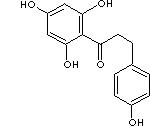|
PHLORETIN |
| Synonyms. Phloretin; Phloretol; 2',4',6'-Trihydroxy-3-(p-hydroxyphenyl)propiophenone; 4,2',4',6'-Tetrahydroxydihydrochalcone; beta-(p-Hydroxyphenyl)-2,4,6-trihydroxypropiophenone; beta-(p-Hydroxyphenyl)phloropropiophenone; Dihydronaringenin; 3-(4-Hydroxyphenyl)-1-(2,4,6-trihydroxyphenyl)propan-1-one |
|
|
| PRODUCT IDENTIFICATION | |
|
CAS RN |
60-82-2 |
|
EINECS RN |
200-488-7 |
|
FORMULA |
C15H14O5 |
|
MOLE WEIGHT |
274.27 |
|
H.S CODE |
2914.50.3000 |
|
SMILES |
c1(C(CCc2ccc(O)cc2)=O)c(cc(O)cc1O)O |
|
CLASSIFICATION |
Calcium Channel Modulator |
|
EXTRA NOTES |
Biochem/physiol Actions:Blocks L-type Ca2+ channels; activates Ca2+-activated K+ channels in amphibian myelinated nerve fibers. Monocarboxylate transporter inhibitor.
Reacts with vic-dicarbonyl compounds such as glyoxal and methylglyoxal, preventing cytotoxic conjugation with biological macromolecules. General description: Major polyphenol found in apple; aglycone of phloridzin.(http://www.sigmaaldrich.com/) |
|
|
| PHYSICAL AND CHEMICAL PROPERTIES | |
|
PHYSICAL STATE. |
White to yellowish powder |
MELTING POINT |
260 ~ 263 C |
|
BOILING POINT |
|
|
DENSITY |
|
|
SOLUBILITY IN WATER |
123 mg/l |
| SOLVENT SOLUBILITY | Soluble in methanol |
|
VAPOR DENSITY |
|
|
log P(octanol-water) |
|
|
VAPOR PRESSURE |
|
|
AUTOIGNITION TEMP |
|
| pKa |
|
|
REFRACTIVE INDEX |
1.573 ~ 1.575 |
|
FLASH POINT |
|
|
| STABILITY AND REACTIVITY | |
| STABILITY | Stable under normal conditions.Light sensitive |
|
INCOMPATIBLE MATERIALS |
Strong oxidizing agents |
| POLYMERIZATION |
Has not been reported |
|
NFPA RATINGS |
Health: 0, Flammability:0, Reactivity: 0 |
|
|
| EXTERNAL LINKS & GENERAL DESCRIPTION |
|
Wikipedia Linking - Phloretin Google Scholar Search - Phloretin Drug Information Portal (U.S. National Library of Medicine) - Phloretin PubChem Compound Summary - Phloretin Drug Bank - Phloretin KEGG (Kyoto Encyclopedia of Genes and Genomes) - Phloretin http://www.ebi.ac.uk/ - Phloretin http://www.ncbi.nlm.nih.gov/ - Phloretin
|
|
|
| SALES SPECIFICATION | |
|
APPEARANCE |
White to yellowish powder |
|
ASSAY |
98.0% min |
|
LOSS ON DRYING |
5.0% max |
|
HEAVY METALS |
10ppm max |
|
As |
1ppm max |
|
Pb |
3ppm max |
|
MICROBIOLOGICAL TEST |
Total Plate Count: 1000 organisms/g max |
|
PARTICLE SIZE |
100 mesh |
|
|
| TRANSPORT & REGULATORY INFORMATION |
|
|
UN NO. |
Not regulated |
| HAZARD CLASS |
|
| PACKING GROUP | |
|
|
| SAFETY INFORMATION |
|
|
HAZARD OVERVIEW |
Irritating to eyes, respiratory system and skin. Target Organs: Skin, Respiratory system, Eyes |
|
GHS |
|
|
SIGNAL WORD |
Warning |
|
PICTOGRAMS |
|
|
HAZARD STATEMENTS |
H315-H319-H335 |
|
P STATEMENTS |
P261-P302+ P352-P305 + P351 + P338 |
| EC DIRECTIVES |
|
| HAZARD CODES |
|
|
RISK PHRASES |
36/37/38 |
|
SAFETY PHRASES |
26-37/39 |

